#Turkestan tulips
Explore tagged Tumblr posts
Text



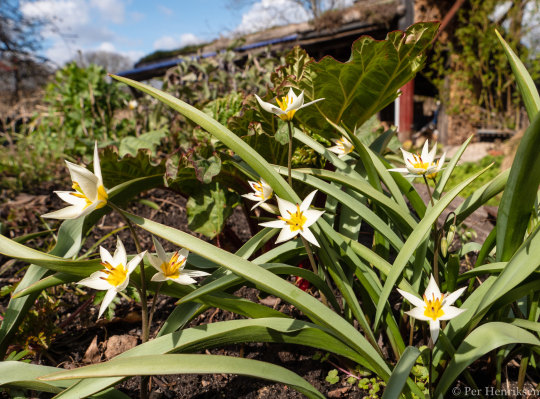
Forår 2022-012 (2) (3) (4) by Per Henriksen
#birds#geese#flowers#daffodils#glory-of-the-snow#chairs waiting#rivers#Turkestan tulips#denmark#copenhagen
0 notes
Text
Turkestan botanical tulip - Tulipa turkestanica L.
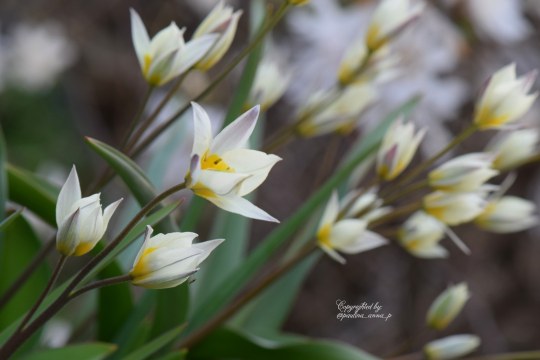
#flower#flowers#flowersofinstagram#flowerphotography#floweroftheday#photooftheday#photo#photography#photoshoot#photogram#photoeveryday#nikon#nikond5300#nikonpolska#nikonphotography#nikonphotographer#beautiful#macro#flowermagic#photographer#macrophotography#makrofotografia#photos#foto#fotografia#fotografie#pic#picture#pictureoftheday#pictures
2 notes
·
View notes
Photo

5 notes
·
View notes
Photo



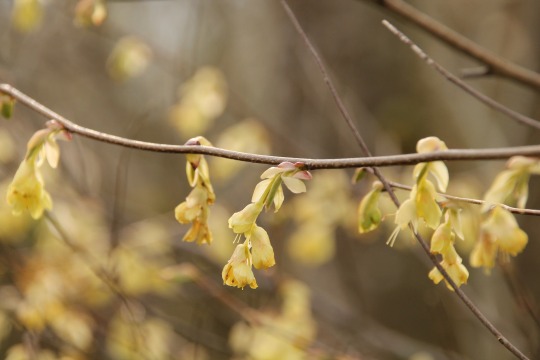
Frühling in Pastell ..... (pastel shades of spring)
Schlehe, Tulipa turkestanica, Blumenhasel (Sloe, Turkestan Tulip, Winterhazel)
#schlehe#sloe#tulipa turkestanica#blumenhasel#winterhazel#spring#nature#mi garden#original photography
5 notes
·
View notes
Photo

Standard Oil Company
There, on our extreme left and near the water, is the country estate of Khedive Ismail Pasha, father of the last Khedive of Egypt who was dethroned by England during the war because of his pro Turkish sentiments. Ismail Pasha’s estate is in Europe but the hills which seem next to it are on the other side, in Asia, and the funny looking buildings on top as well as the low buildings on the shore are the depots of the Standard Oil Company. They used to belong to an uncle of Madame Ismet Bey but now they belong to the Standard Oil.
No, her uncle has not sold his rights: it just happened that the Standard Oil stepped in before he had time to have them renewed. His house, or what used to be his house is the one just opposite us. He used to have the most beautiful caiks in the Bosporus, ten or fifteen years ago, and his wife and his daughters would go every Friday to the Sweet Waters of Asia in those long, slim racing barks, with tapering ends, rowed by three or sometimes four boatmen with flowing sleeves, a beautiful embroidered carpet covering the stern, its corners trailing in the sea. He used to have a passion for flowers and you can see even from here the roof of the hothouse where he grew the most exotic plants he could think of: rare varieties of chrysanthemums and poppies from the Far East private tours istanbul, tulips from Turkestan and Persia, mogra and lotus trees from India. Now he has sold his house and has barely enough to live on.
Side of Bosporus
The Sweet Waters of Asia are nearby, just between the ruins of the old mediaeval castle built by Sultan Mahomet the Conqueror before he laid siege to Byzance and the Imperial Kiosks of Chiok Soo, a real jewel. Further to the right that low, rambling white building is the yali of the family of Mahmoud Pasha. They entertain a great deal and have asked us to tea next Sunday. Now we pass again without realizing it to the European shores; the old castle on the hill is the Castle of Europe, the first stronghold of the Turks on this side of the Bosporus, and the big building next to it is the famous Robert College, the American College for Boys.
The view is so gorgeous that it cannot be described. I wish I had a canvas and the technique of Courbet, the talent of Turner and the daring of Whistler to paint in all its splendor the clear sky of the Bosporus, so clear and so blue that the eyes can almost see that it is endless the red and gold flakes of its dark green vegetation, so luxuriant that it speaks of centuries of loving care the peaceful atmosphere of its old houses, so restful that you can feel that generations of thinkers and philosophers have meditated behind their walls the harmonious outline of its hills, so smilingly round that only immemorial age can have so smoothly curved them the mystery of its always running currents, running so continuously that they should have long ago emptied the Black Sea into the Mediterranean.
1 note
·
View note
Text
17 au 23 octobre 2022
Bulb planting continues... I planted the species bulbs into the garden then some cultivars into the cutting beds and some into pots for around the house.

Tulipa turkestanica bulbs being planted and I hope they naturalise quickly. I only planted 750 of them... I just tossed them and planted them where they landed.

I finished raking and rolling the meadow area, for the second time this year. It did a number on my elbows. Mme. and I sowed the seeds on Friday and just as we finished, rain arrived and gave it all a good shower for the rest of the afternoon.

During the week, Lucien called around a found a place in Vallarus where I could have my new solid tyre for my trottinette fitted. I tried and it was impossible for me to stretch it around the wheel. It now rides so smoothly and I don’t have to worry about any more flat tyres, in the front anyway. It is always nice to have him down for a visit. He went home Thursday.
Sunday I met up with Ilze and Daniela for a nice lunch at a beach-side restaurant. We also did a lot of plane spotting.

Plant of the week
Liliaceae Tulipa turkestanica (Regel) Regel

common name(s) - Turkestan tulip synonym(s) - Homotypic : Tulipa sylvestris var. turkestanica Regel conservation rating - none native to - Turkistan to China location - Domaine de l’Orangerie leaves - narrow, greyish-green flowers - racemes of up to 12 star-shaped white flowers 30mm to 50mm in width, showing deep yellow at the base, flushed reddish-green on the outside fruit - capsule, oblong, swollen towards a blunt apex often splits at an early stage habit - bulbous perennial to 300mm in height habitat - stony slopes, river margins and rocky ledges between 1,800m and 2,500m pests - slugs, aphids, stem and bulb eelworm, squirrels disease - tulip fire, bulb rots hardiness - to -15ºC (H5) soil - well-drained chalk, sand, loam sun - full sun propagation - separating offsets, naturalises easily pruning - deadhead after flowering nomenclature - Liliaceae - lilium - in Virgil, Celtic, li, white; Tulipa - original seed sent by Ogier Gheselin de Busbecq (1522-92), Viennese Ambassador to Suliman the Magnificent, described as tulipan, from the Persian name, dulbend or thoulyban, for a turban; turkestanica - from Turkestan NB - RHS AGM; tulips of the Eriostemenes group cannot be crossed with garden tulips
References :
Everett, Diana, (2013) “The Genus Tulipa”, Royal Botanic gardens, Kew, p. 142; ISBN: 978-1-84246-481-6
Fluwel [online] (photo) https://www.fluwel.fr/tulipe-turkestanica.html [13 Nov 22]
Gardenia [online] https://www.gardenia.net/plant/tulipa-turkestanica-botanical-tulip [13 Nov 22]
Gledhill, David, (2008) “The Names of Plants”, fourth edition; Cambridge University Press; ISBN: 978-0-52168-553-5
IUCN [online] http://www.iucnredlist.org/search [13 Nov 22]
Plants of the World [online] https://powo.science.kew.org/taxon/urn:lsid:ipni.org:names:543131-1 [13 Nov 22]
Royal Horticultural Society [online] https://www.rhs.org.uk/plants/18552/i-tulipa-turkestanica-i-(15)/details [13 Nov 22]
Wikipedia [online] https://en.wikipedia.org/wiki/Tulipa_turkestanica [13 Nov 22]
World Flora Online [online] http://www.worldfloraonline.org/taxon/wfo-0000746306 [13 Nov 22]
0 notes
Text
Discovering the world
Kyrgyzstan 🇰🇬
Basic facts
Official name: Кыргыз Республикасы (Kyrgyz Respublikasy)/Кыргызская Республика (Kyrgyzskaya Respublika) (Kyrgyz/Russian) (Kyrgyz Republic)
Capital city: Bishkek
Population: 6.7 million (2023)
Demonym: Kyrgyzstani
Type of government: unitary presidential republic
Head of state and government: Sadyr Japarov (President)
Gross domestic product (purchasing power parity): $48.05 billion (2024)
Gini coefficient of wealth inequality: 29% (low) (2020)
Human Development Index: 0.701 (high) (2022)
Currency: som (KGS)
Fun fact: It is home to the world’s largest walnut forest.
Etymology
The country’s name consists of the Turkic word for “we are forty”, which is believed to refer to the forty clans of legendary hero Manas, and the Persian suffix -stan, which means “place of”.
Geography
Kyrgyzstan is located in Central Asia and borders Kazakhstan to the north, China to the east and southeast, Tajikistan to the south, and Uzbekistan to the west.
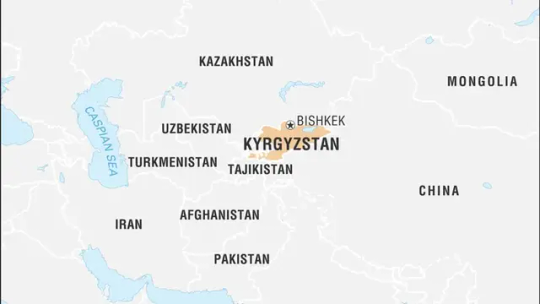
There are six main climates: warm-summer humid continental in the northeast, Mediterranean-influenced warm-summer humid continental in the west, subarctic and tundra in the center, east, and southwest, cold desert in the northwest and southwest, and cold steppe in the rest. Temperatures range from −10 °C (14 °F) in winter to 32 °C (89.6 °F) in summer. The average annual temperature is 9.6 °C (49.2 °F).
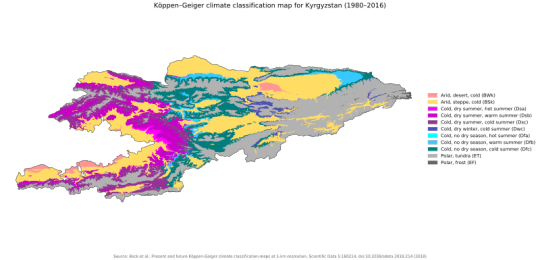
The country is divided into seven regions (oblystar/oblasti), which are further divided into 44 districts (aymaqtar/rayony). The largest cities in Kyrgyzstan are Bishkek, Osh, Jalalabad, Karakol, and Tokmok.
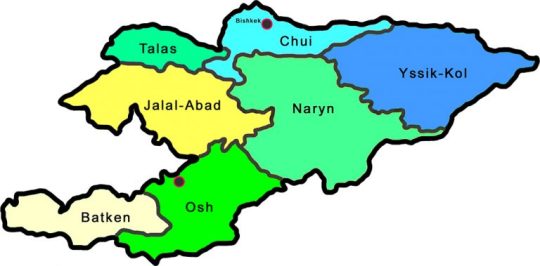
History
30-375: Kushan Empire
440s-560: Hephthalite Empire
539-1207: Kyrgyz Khaganate
552-603: First Turkic Khaganate
603-742: Western Turkic Khaganate
682-744: Second Turkic Khaganate
744-840: Uyghur Khaganate
843-1347: Qocho Kingdom
1223-1266: Mongol Empire
1266-1347: Chagatai Khanate
1501-1785: Khanate of Bukhara
1709-1876: Khanate of Kokand
1876-1917: Russian Empire
1917-1918: Turkestan Autonomy
1918-1924: Turkestan Autonomous Soviet Socialist Republic
1924-1926: Kara-Kirghiz Autonomous Oblast
1926-1936: Kirghiz Autonomous Soviet Socialist Republic
1936-1990: Kirghiz Soviet Socialist Republic
1990-1991: Republic of Kyrgyzstan
1991-present: Kyrgyz Republic
2005: Tulip Revolution
2010: Second Kyrgyz Revolution
2020: Third Kyrgyz Revolution
Economy
Kyrgyzstan mainly imports from China, Russia, and Uzbekistan and exports to the United States, Kazakhstan, and Russia. Its top exports are dry pulses, sheep and goats, and cotton.
It has antimony, coal, gold, and uranium reserves. Services represent 54.2% of the GDP, followed by industry (31.2%) and agriculture (14.6%).
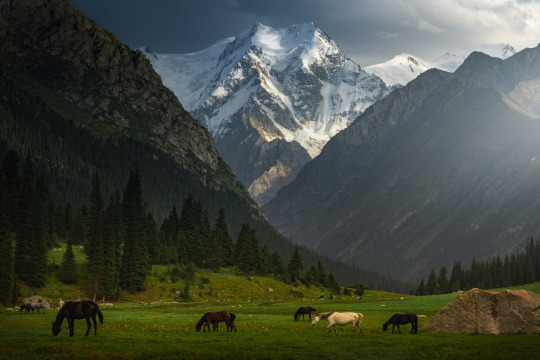
Kyrgyzstan is a member of the Collective Security Treaty Organization, the Commonwealth of Independent States, the Eurasian Economic Union, the Organization for Security and Cooperation in Europe, the Organization of Islamic Cooperation, the Organization of Turkic States, and the Shanghai Cooperation Organization.
Demographics
77.8% of the population is Kyrgyz, while Uzbeks represent 14.2% and Russians 3.8%. The main religion is Islam, practiced by 91% of the population, the majority of which is Sunni.
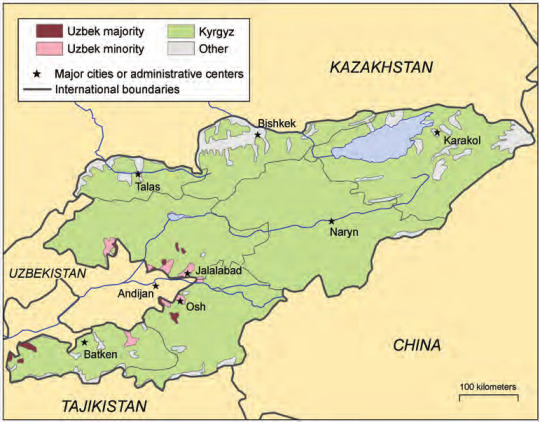
It has a positive net migration rate and a fertility rate of 3 children per woman. 38% of the population lives in urban areas. Life expectancy is 71.9 years and the median age is 24 years. The literacy rate is 99.2%.
Languages
The official languages of the country are Kyrgyz and Russian, spoken by 61.1% and 37.3% of the population, respectively.
Culture
Kyrgyzstan is known for its carpets and tapestries and nomadic farming. Bride kidnapping, although illegal, is still practiced.
Men traditionally wear a shirt (keynek), wide, embroidered pants (chalbar), a wide belt (kemer), a felt robe (kementay), and a white felt hat (kalpak). Women wear a white shirt (keynek) and long pants or a dress, an embroidered vest (chyptama), and a white muslin turban (elechek) or a conical hat with a veil (topu).

Architecture
Traditional houses in Kyrgyzstan are conical wooden structures covered in felt and wool.
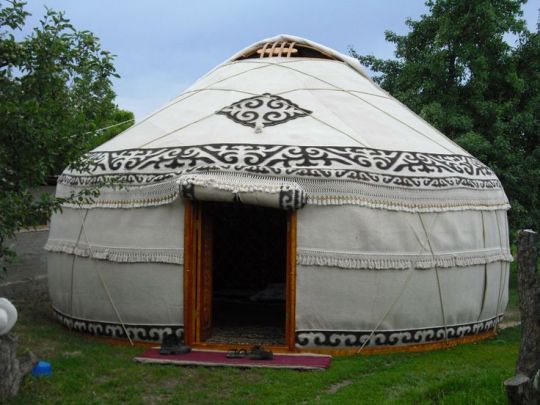
Cuisine
The Kyrgyzstani diet is based on dairy products, meat, rice, and vegetables. Typical dishes include chiuchiuk (horse sausage), dimlama (a stew of meat, onions, potatoes, and vegetables), langman (a dish of meat, noodles, and vegetables), oromo (a steamed pie with minced meat and onions), and qurut (tangy, dried yogurt balls).
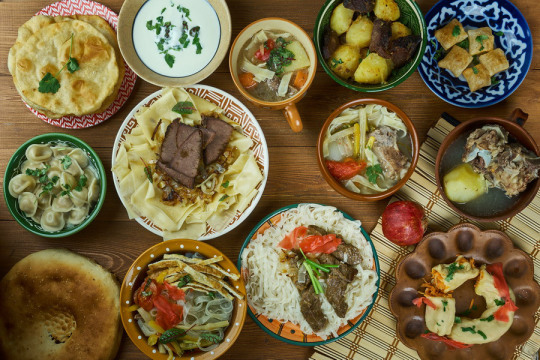
Holidays and festivals
Like other Muslim and Christian countries, Kyrgyzstan celebrates Orthodox Christmas, Eid al-Fitr, and Eid al-Adha. It also commemorates New Year’s Day, International Women’s Day, Persian New Year, and Labor Day.
Specific Kyrgyzstani holidays include Fatherland Defenders’ Day on February 23, Day of National Revolution on April 7, Constitution Day on May 5, Remembrance Day on May 8, Victory Day on May 9, Independence Day on August 31, and Days of History and Commemoration of Ancestors on November 7 and 8.

Independence Day
Other celebrations include the Birds of Prey Festival, the Kyrgyz Kochu Festival, which showcases the art of felt-making, and the National Horse Festival.
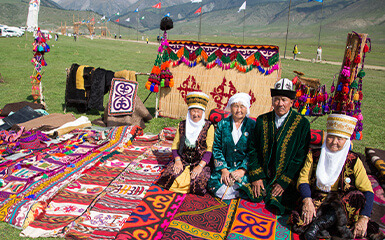
Kyrgyz Kochu Festival
Landmarks
There are three UNESCO World Heritage Sites: Silk Roads: the Routes Network of Chang’an-Tianshan Corridor, Sulaiman-Too Sacred Mountain, and Western Tien-Shan.

Sulaiman-Too Sacred Mountain
Other landmarks include the Ala Archa National Park, the Burana Tower, the Holy Trinity Russian Orthodox Cathedral, the Kol-Tor Lake, and the Ruh Ordo Cultural Center.
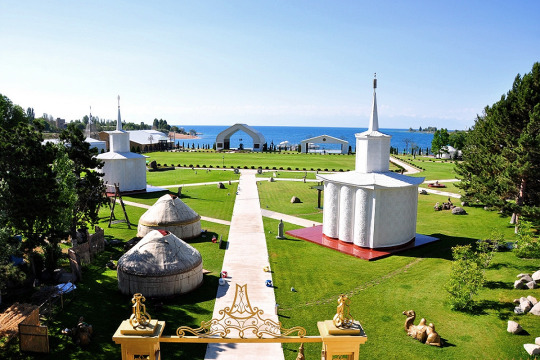
Ruh Ordo Cultural Center
Famous people
Aisuluu Tynybekova - wrestler
Bübüsara Beyshenalieva - dancer
Chinghiz Aitmatov - writer
Kasym Tynystanov - poet
Mirlan Murzayev - soccer player
Salamat Sadikova - singer
Salizhan Sharipov - astronaut
Samal Yeslyamova - actress
Suimonkul Chokmorov - actor and artist
Valentina Shevchenko - mixed martial artist
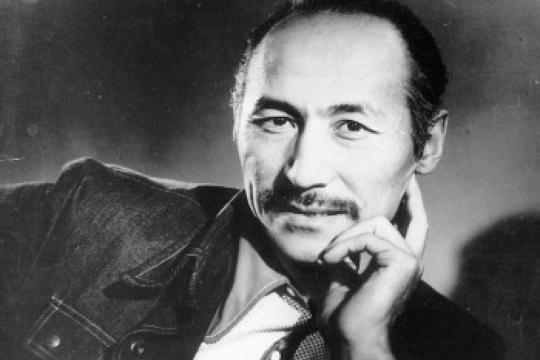
Suimonkul Chokmorov
You can find out more about life in Kyrgyzstan in this article and this video.
4 notes
·
View notes
Photo



Plant of the Day Thursday 22 March 2018
The bold red flower of Tulipa greigii (Turkestan tulip, Greig’s tulip) is only half the story as it also produces attractive broad, glaucous foliage with reddish streaking along the leaf. This species has produced many hybrids, which flower in early or mid-spring.
Jill Raggett
#tulipa#tulip#tulips#alpinehouse#alpineglasshouse#redflowers#foliage#cambridgebotanicgarden#cambridge#mhort#horticulture#wucplant#writtledesign
78 notes
·
View notes
Photo

Standard Oil Company
There, on our extreme left and near the water, is the country estate of Khedive Ismail Pasha, father of the last Khedive of Egypt who was dethroned by England during the war because of his pro Turkish sentiments. Ismail Pasha’s estate is in Europe but the hills which seem next to it are on the other side, in Asia, and the funny looking buildings on top as well as the low buildings on the shore are the depots of the Standard Oil Company. They used to belong to an uncle of Madame Ismet Bey but now they belong to the Standard Oil.
No, her uncle has not sold his rights: it just happened that the Standard Oil stepped in before he had time to have them renewed. His house, or what used to be his house is the one just opposite us. He used to have the most beautiful caiks in the Bosporus, ten or fifteen years ago, and his wife and his daughters would go every Friday to the Sweet Waters of Asia in those long, slim racing barks, with tapering ends, rowed by three or sometimes four boatmen with flowing sleeves, a beautiful embroidered carpet covering the stern, its corners trailing in the sea. He used to have a passion for flowers and you can see even from here the roof of the hothouse where he grew the most exotic plants he could think of: rare varieties of chrysanthemums and poppies from the Far East private tours istanbul, tulips from Turkestan and Persia, mogra and lotus trees from India. Now he has sold his house and has barely enough to live on.
Side of Bosporus
The Sweet Waters of Asia are nearby, just between the ruins of the old mediaeval castle built by Sultan Mahomet the Conqueror before he laid siege to Byzance and the Imperial Kiosks of Chiok Soo, a real jewel. Further to the right that low, rambling white building is the yali of the family of Mahmoud Pasha. They entertain a great deal and have asked us to tea next Sunday. Now we pass again without realizing it to the European shores; the old castle on the hill is the Castle of Europe, the first stronghold of the Turks on this side of the Bosporus, and the big building next to it is the famous Robert College, the American College for Boys.
The view is so gorgeous that it cannot be described. I wish I had a canvas and the technique of Courbet, the talent of Turner and the daring of Whistler to paint in all its splendor the clear sky of the Bosporus, so clear and so blue that the eyes can almost see that it is endless the red and gold flakes of its dark green vegetation, so luxuriant that it speaks of centuries of loving care the peaceful atmosphere of its old houses, so restful that you can feel that generations of thinkers and philosophers have meditated behind their walls the harmonious outline of its hills, so smilingly round that only immemorial age can have so smoothly curved them the mystery of its always running currents, running so continuously that they should have long ago emptied the Black Sea into the Mediterranean.
0 notes
Photo

Standard Oil Company
There, on our extreme left and near the water, is the country estate of Khedive Ismail Pasha, father of the last Khedive of Egypt who was dethroned by England during the war because of his pro Turkish sentiments. Ismail Pasha’s estate is in Europe but the hills which seem next to it are on the other side, in Asia, and the funny looking buildings on top as well as the low buildings on the shore are the depots of the Standard Oil Company. They used to belong to an uncle of Madame Ismet Bey but now they belong to the Standard Oil.
No, her uncle has not sold his rights: it just happened that the Standard Oil stepped in before he had time to have them renewed. His house, or what used to be his house is the one just opposite us. He used to have the most beautiful caiks in the Bosporus, ten or fifteen years ago, and his wife and his daughters would go every Friday to the Sweet Waters of Asia in those long, slim racing barks, with tapering ends, rowed by three or sometimes four boatmen with flowing sleeves, a beautiful embroidered carpet covering the stern, its corners trailing in the sea. He used to have a passion for flowers and you can see even from here the roof of the hothouse where he grew the most exotic plants he could think of: rare varieties of chrysanthemums and poppies from the Far East private tours istanbul, tulips from Turkestan and Persia, mogra and lotus trees from India. Now he has sold his house and has barely enough to live on.
Side of Bosporus
The Sweet Waters of Asia are nearby, just between the ruins of the old mediaeval castle built by Sultan Mahomet the Conqueror before he laid siege to Byzance and the Imperial Kiosks of Chiok Soo, a real jewel. Further to the right that low, rambling white building is the yali of the family of Mahmoud Pasha. They entertain a great deal and have asked us to tea next Sunday. Now we pass again without realizing it to the European shores; the old castle on the hill is the Castle of Europe, the first stronghold of the Turks on this side of the Bosporus, and the big building next to it is the famous Robert College, the American College for Boys.
The view is so gorgeous that it cannot be described. I wish I had a canvas and the technique of Courbet, the talent of Turner and the daring of Whistler to paint in all its splendor the clear sky of the Bosporus, so clear and so blue that the eyes can almost see that it is endless the red and gold flakes of its dark green vegetation, so luxuriant that it speaks of centuries of loving care the peaceful atmosphere of its old houses, so restful that you can feel that generations of thinkers and philosophers have meditated behind their walls the harmonious outline of its hills, so smilingly round that only immemorial age can have so smoothly curved them the mystery of its always running currents, running so continuously that they should have long ago emptied the Black Sea into the Mediterranean.
0 notes
Photo

Standard Oil Company
There, on our extreme left and near the water, is the country estate of Khedive Ismail Pasha, father of the last Khedive of Egypt who was dethroned by England during the war because of his pro Turkish sentiments. Ismail Pasha’s estate is in Europe but the hills which seem next to it are on the other side, in Asia, and the funny looking buildings on top as well as the low buildings on the shore are the depots of the Standard Oil Company. They used to belong to an uncle of Madame Ismet Bey but now they belong to the Standard Oil.
No, her uncle has not sold his rights: it just happened that the Standard Oil stepped in before he had time to have them renewed. His house, or what used to be his house is the one just opposite us. He used to have the most beautiful caiks in the Bosporus, ten or fifteen years ago, and his wife and his daughters would go every Friday to the Sweet Waters of Asia in those long, slim racing barks, with tapering ends, rowed by three or sometimes four boatmen with flowing sleeves, a beautiful embroidered carpet covering the stern, its corners trailing in the sea. He used to have a passion for flowers and you can see even from here the roof of the hothouse where he grew the most exotic plants he could think of: rare varieties of chrysanthemums and poppies from the Far East private tours istanbul, tulips from Turkestan and Persia, mogra and lotus trees from India. Now he has sold his house and has barely enough to live on.
Side of Bosporus
The Sweet Waters of Asia are nearby, just between the ruins of the old mediaeval castle built by Sultan Mahomet the Conqueror before he laid siege to Byzance and the Imperial Kiosks of Chiok Soo, a real jewel. Further to the right that low, rambling white building is the yali of the family of Mahmoud Pasha. They entertain a great deal and have asked us to tea next Sunday. Now we pass again without realizing it to the European shores; the old castle on the hill is the Castle of Europe, the first stronghold of the Turks on this side of the Bosporus, and the big building next to it is the famous Robert College, the American College for Boys.
The view is so gorgeous that it cannot be described. I wish I had a canvas and the technique of Courbet, the talent of Turner and the daring of Whistler to paint in all its splendor the clear sky of the Bosporus, so clear and so blue that the eyes can almost see that it is endless the red and gold flakes of its dark green vegetation, so luxuriant that it speaks of centuries of loving care the peaceful atmosphere of its old houses, so restful that you can feel that generations of thinkers and philosophers have meditated behind their walls the harmonious outline of its hills, so smilingly round that only immemorial age can have so smoothly curved them the mystery of its always running currents, running so continuously that they should have long ago emptied the Black Sea into the Mediterranean.
0 notes
Photo

Standard Oil Company
There, on our extreme left and near the water, is the country estate of Khedive Ismail Pasha, father of the last Khedive of Egypt who was dethroned by England during the war because of his pro Turkish sentiments. Ismail Pasha’s estate is in Europe but the hills which seem next to it are on the other side, in Asia, and the funny looking buildings on top as well as the low buildings on the shore are the depots of the Standard Oil Company. They used to belong to an uncle of Madame Ismet Bey but now they belong to the Standard Oil.
No, her uncle has not sold his rights: it just happened that the Standard Oil stepped in before he had time to have them renewed. His house, or what used to be his house is the one just opposite us. He used to have the most beautiful caiks in the Bosporus, ten or fifteen years ago, and his wife and his daughters would go every Friday to the Sweet Waters of Asia in those long, slim racing barks, with tapering ends, rowed by three or sometimes four boatmen with flowing sleeves, a beautiful embroidered carpet covering the stern, its corners trailing in the sea. He used to have a passion for flowers and you can see even from here the roof of the hothouse where he grew the most exotic plants he could think of: rare varieties of chrysanthemums and poppies from the Far East private tours istanbul, tulips from Turkestan and Persia, mogra and lotus trees from India. Now he has sold his house and has barely enough to live on.
Side of Bosporus
The Sweet Waters of Asia are nearby, just between the ruins of the old mediaeval castle built by Sultan Mahomet the Conqueror before he laid siege to Byzance and the Imperial Kiosks of Chiok Soo, a real jewel. Further to the right that low, rambling white building is the yali of the family of Mahmoud Pasha. They entertain a great deal and have asked us to tea next Sunday. Now we pass again without realizing it to the European shores; the old castle on the hill is the Castle of Europe, the first stronghold of the Turks on this side of the Bosporus, and the big building next to it is the famous Robert College, the American College for Boys.
The view is so gorgeous that it cannot be described. I wish I had a canvas and the technique of Courbet, the talent of Turner and the daring of Whistler to paint in all its splendor the clear sky of the Bosporus, so clear and so blue that the eyes can almost see that it is endless the red and gold flakes of its dark green vegetation, so luxuriant that it speaks of centuries of loving care the peaceful atmosphere of its old houses, so restful that you can feel that generations of thinkers and philosophers have meditated behind their walls the harmonious outline of its hills, so smilingly round that only immemorial age can have so smoothly curved them the mystery of its always running currents, running so continuously that they should have long ago emptied the Black Sea into the Mediterranean.
0 notes
Photo

Standard Oil Company
There, on our extreme left and near the water, is the country estate of Khedive Ismail Pasha, father of the last Khedive of Egypt who was dethroned by England during the war because of his pro Turkish sentiments. Ismail Pasha’s estate is in Europe but the hills which seem next to it are on the other side, in Asia, and the funny looking buildings on top as well as the low buildings on the shore are the depots of the Standard Oil Company. They used to belong to an uncle of Madame Ismet Bey but now they belong to the Standard Oil.
No, her uncle has not sold his rights: it just happened that the Standard Oil stepped in before he had time to have them renewed. His house, or what used to be his house is the one just opposite us. He used to have the most beautiful caiks in the Bosporus, ten or fifteen years ago, and his wife and his daughters would go every Friday to the Sweet Waters of Asia in those long, slim racing barks, with tapering ends, rowed by three or sometimes four boatmen with flowing sleeves, a beautiful embroidered carpet covering the stern, its corners trailing in the sea. He used to have a passion for flowers and you can see even from here the roof of the hothouse where he grew the most exotic plants he could think of: rare varieties of chrysanthemums and poppies from the Far East private tours istanbul, tulips from Turkestan and Persia, mogra and lotus trees from India. Now he has sold his house and has barely enough to live on.
Side of Bosporus
The Sweet Waters of Asia are nearby, just between the ruins of the old mediaeval castle built by Sultan Mahomet the Conqueror before he laid siege to Byzance and the Imperial Kiosks of Chiok Soo, a real jewel. Further to the right that low, rambling white building is the yali of the family of Mahmoud Pasha. They entertain a great deal and have asked us to tea next Sunday. Now we pass again without realizing it to the European shores; the old castle on the hill is the Castle of Europe, the first stronghold of the Turks on this side of the Bosporus, and the big building next to it is the famous Robert College, the American College for Boys.
The view is so gorgeous that it cannot be described. I wish I had a canvas and the technique of Courbet, the talent of Turner and the daring of Whistler to paint in all its splendor the clear sky of the Bosporus, so clear and so blue that the eyes can almost see that it is endless the red and gold flakes of its dark green vegetation, so luxuriant that it speaks of centuries of loving care the peaceful atmosphere of its old houses, so restful that you can feel that generations of thinkers and philosophers have meditated behind their walls the harmonious outline of its hills, so smilingly round that only immemorial age can have so smoothly curved them the mystery of its always running currents, running so continuously that they should have long ago emptied the Black Sea into the Mediterranean.
0 notes
Photo

Standard Oil Company
There, on our extreme left and near the water, is the country estate of Khedive Ismail Pasha, father of the last Khedive of Egypt who was dethroned by England during the war because of his pro Turkish sentiments. Ismail Pasha’s estate is in Europe but the hills which seem next to it are on the other side, in Asia, and the funny looking buildings on top as well as the low buildings on the shore are the depots of the Standard Oil Company. They used to belong to an uncle of Madame Ismet Bey but now they belong to the Standard Oil.
No, her uncle has not sold his rights: it just happened that the Standard Oil stepped in before he had time to have them renewed. His house, or what used to be his house is the one just opposite us. He used to have the most beautiful caiks in the Bosporus, ten or fifteen years ago, and his wife and his daughters would go every Friday to the Sweet Waters of Asia in those long, slim racing barks, with tapering ends, rowed by three or sometimes four boatmen with flowing sleeves, a beautiful embroidered carpet covering the stern, its corners trailing in the sea. He used to have a passion for flowers and you can see even from here the roof of the hothouse where he grew the most exotic plants he could think of: rare varieties of chrysanthemums and poppies from the Far East private tours istanbul, tulips from Turkestan and Persia, mogra and lotus trees from India. Now he has sold his house and has barely enough to live on.
Side of Bosporus
The Sweet Waters of Asia are nearby, just between the ruins of the old mediaeval castle built by Sultan Mahomet the Conqueror before he laid siege to Byzance and the Imperial Kiosks of Chiok Soo, a real jewel. Further to the right that low, rambling white building is the yali of the family of Mahmoud Pasha. They entertain a great deal and have asked us to tea next Sunday. Now we pass again without realizing it to the European shores; the old castle on the hill is the Castle of Europe, the first stronghold of the Turks on this side of the Bosporus, and the big building next to it is the famous Robert College, the American College for Boys.
The view is so gorgeous that it cannot be described. I wish I had a canvas and the technique of Courbet, the talent of Turner and the daring of Whistler to paint in all its splendor the clear sky of the Bosporus, so clear and so blue that the eyes can almost see that it is endless the red and gold flakes of its dark green vegetation, so luxuriant that it speaks of centuries of loving care the peaceful atmosphere of its old houses, so restful that you can feel that generations of thinkers and philosophers have meditated behind their walls the harmonious outline of its hills, so smilingly round that only immemorial age can have so smoothly curved them the mystery of its always running currents, running so continuously that they should have long ago emptied the Black Sea into the Mediterranean.
0 notes
Photo

Standard Oil Company
There, on our extreme left and near the water, is the country estate of Khedive Ismail Pasha, father of the last Khedive of Egypt who was dethroned by England during the war because of his pro Turkish sentiments. Ismail Pasha’s estate is in Europe but the hills which seem next to it are on the other side, in Asia, and the funny looking buildings on top as well as the low buildings on the shore are the depots of the Standard Oil Company. They used to belong to an uncle of Madame Ismet Bey but now they belong to the Standard Oil.
No, her uncle has not sold his rights: it just happened that the Standard Oil stepped in before he had time to have them renewed. His house, or what used to be his house is the one just opposite us. He used to have the most beautiful caiks in the Bosporus, ten or fifteen years ago, and his wife and his daughters would go every Friday to the Sweet Waters of Asia in those long, slim racing barks, with tapering ends, rowed by three or sometimes four boatmen with flowing sleeves, a beautiful embroidered carpet covering the stern, its corners trailing in the sea. He used to have a passion for flowers and you can see even from here the roof of the hothouse where he grew the most exotic plants he could think of: rare varieties of chrysanthemums and poppies from the Far East private tours istanbul, tulips from Turkestan and Persia, mogra and lotus trees from India. Now he has sold his house and has barely enough to live on.
Side of Bosporus
The Sweet Waters of Asia are nearby, just between the ruins of the old mediaeval castle built by Sultan Mahomet the Conqueror before he laid siege to Byzance and the Imperial Kiosks of Chiok Soo, a real jewel. Further to the right that low, rambling white building is the yali of the family of Mahmoud Pasha. They entertain a great deal and have asked us to tea next Sunday. Now we pass again without realizing it to the European shores; the old castle on the hill is the Castle of Europe, the first stronghold of the Turks on this side of the Bosporus, and the big building next to it is the famous Robert College, the American College for Boys.
The view is so gorgeous that it cannot be described. I wish I had a canvas and the technique of Courbet, the talent of Turner and the daring of Whistler to paint in all its splendor the clear sky of the Bosporus, so clear and so blue that the eyes can almost see that it is endless the red and gold flakes of its dark green vegetation, so luxuriant that it speaks of centuries of loving care the peaceful atmosphere of its old houses, so restful that you can feel that generations of thinkers and philosophers have meditated behind their walls the harmonious outline of its hills, so smilingly round that only immemorial age can have so smoothly curved them the mystery of its always running currents, running so continuously that they should have long ago emptied the Black Sea into the Mediterranean.
0 notes
Photo

Standard Oil Company
There, on our extreme left and near the water, is the country estate of Khedive Ismail Pasha, father of the last Khedive of Egypt who was dethroned by England during the war because of his pro Turkish sentiments. Ismail Pasha’s estate is in Europe but the hills which seem next to it are on the other side, in Asia, and the funny looking buildings on top as well as the low buildings on the shore are the depots of the Standard Oil Company. They used to belong to an uncle of Madame Ismet Bey but now they belong to the Standard Oil.
No, her uncle has not sold his rights: it just happened that the Standard Oil stepped in before he had time to have them renewed. His house, or what used to be his house is the one just opposite us. He used to have the most beautiful caiks in the Bosporus, ten or fifteen years ago, and his wife and his daughters would go every Friday to the Sweet Waters of Asia in those long, slim racing barks, with tapering ends, rowed by three or sometimes four boatmen with flowing sleeves, a beautiful embroidered carpet covering the stern, its corners trailing in the sea. He used to have a passion for flowers and you can see even from here the roof of the hothouse where he grew the most exotic plants he could think of: rare varieties of chrysanthemums and poppies from the Far East private tours istanbul, tulips from Turkestan and Persia, mogra and lotus trees from India. Now he has sold his house and has barely enough to live on.
Side of Bosporus
The Sweet Waters of Asia are nearby, just between the ruins of the old mediaeval castle built by Sultan Mahomet the Conqueror before he laid siege to Byzance and the Imperial Kiosks of Chiok Soo, a real jewel. Further to the right that low, rambling white building is the yali of the family of Mahmoud Pasha. They entertain a great deal and have asked us to tea next Sunday. Now we pass again without realizing it to the European shores; the old castle on the hill is the Castle of Europe, the first stronghold of the Turks on this side of the Bosporus, and the big building next to it is the famous Robert College, the American College for Boys.
The view is so gorgeous that it cannot be described. I wish I had a canvas and the technique of Courbet, the talent of Turner and the daring of Whistler to paint in all its splendor the clear sky of the Bosporus, so clear and so blue that the eyes can almost see that it is endless the red and gold flakes of its dark green vegetation, so luxuriant that it speaks of centuries of loving care the peaceful atmosphere of its old houses, so restful that you can feel that generations of thinkers and philosophers have meditated behind their walls the harmonious outline of its hills, so smilingly round that only immemorial age can have so smoothly curved them the mystery of its always running currents, running so continuously that they should have long ago emptied the Black Sea into the Mediterranean.
0 notes